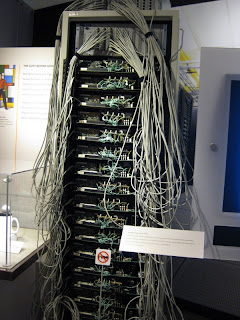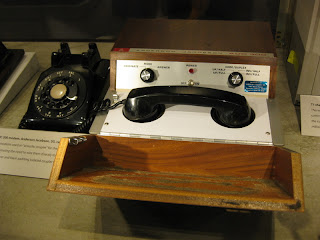There are some things that should always be enjoyed alone. Like hula-hooping naked, or eating a whole packet of Chocolate Hobnobs in one sitting. To this list I can add "visiting the Computer History Museum" and its massive new Revolution exhibition that opened a few weeks ago.
Despite mentioning numerous times to my supposedly educated friends that I was heading to this Mecca of knowledge and fun, I had absolutely zero offers of company. Maybe it's because everyone else has jobs now. Whatever - on this rainy Friday morning I caught the CalTrain down to Mountain View and walked to the newly renovated building in the heart of Silicon Valley.
Being on my sweeney turned out to be a blessing, as I enjoyed over three hours of pleasure unadulterated by companions who may have got a little bored learning how a slide rule works, or marvelling at a reconstructed Babbage Difference Engine, or even playing Space War on a PDP-1. I did resist buying the "Complete Geek Package" (including t-shirt and silver pin badge) and went for standard admission. If you're willing to part with $500k you can become a "giga-donor".
The place is a vast treasure trove of all the most important things in the world. Along with Cray supercomputers (once $10m each, now deployed as couches) and an original Enigma machine, there's an Apple-1 built and signed by Steve Wozniak, the first computer mouse (and the b&w film made to demonstrate how to use it), the tea pot that started the computer modelling and animation revolution (because everything has to start with a decent cup of tea), 1/2 of the computer that beat Kasparov at chess, and, unfairly hidden, a ZX Spectrum.
Yes, it was Christmas and birthday all rolled into one! A group of noisy school children inevitably breezed through, competing with one another over who had played the most games consoles on display. Ha! I was ready to give them a clip around the ear and tell them what it was like to paint on the Apple ][. They were whisked away by their teacher, foolishly bypassing the section on the philosophy of hypertext, tapping on their 4th-generation iPhones and Gameboy DS Lites - none of which were to be found in the display cases. As with all things computing, I guess the museum is already out-of-date.
This is where it is all happening. Or happened.
The mainstay of every engineering student back in the day.
Two of computing's most important figures and yes, they're both British.
IBM took a while to focus.
A genuine WW2 Enigma machine!
Why don't modern computers look like this? It's far more romantic.
I concur.
The Neiman-Marcus Honeywell Kitchen Computer. At $10k it was what every modern 1960s housewife needed (with integral chopping board). Strangely it didn't catch on, as this great article discusses.
They keep getting faster.
I always wanted one of these!
But I did have one of these. What's it doing in a museum?
A computer that paints, and its none-too-shabby output.
This is the teapot that started the computer graphics revolution. It's true! This finally solves why that teapot kept turning up in the Windows screensaver.
Ergonomics were not around when the first mouse was invented.
Here's the man!

And me playing. Although this turned out to be a re-written version! Fairly shocking when you realise quite how intricate the original ghost's behaviour was.
Debates still rage in the Davies household about whether Emily really did take the family Tetris crown with 169 lines. She could never offer documentary proof.
An original Apple-1, built by Woz himself!
The rather more important ZX Spectrum.
I had one of these too!
This was Google's first search server. Everyone who typed in "Britney Spears" went here.
Modem. Old school.
The first piece of spam ever sent.
Now this is a real computer - a PDP-1.
Can self-satisfaction be programmed?
A Difference Engine! Babbage designed this but it was never built in his lifetime (150 years passed, actually, and then a few came along at once).
Me and my Cray 1 Supercomputer. We're after a sofa.


























